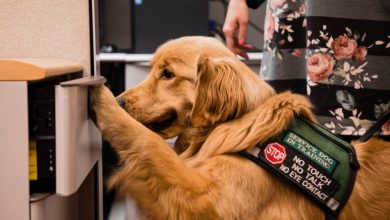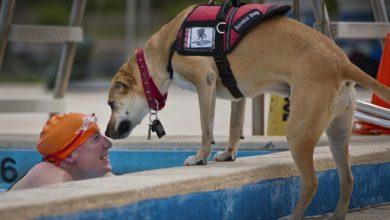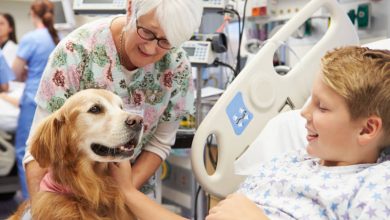Pets & Animals
What Are The Different Types Of Service Dogs?
People are surprised to learn that there are more than a dozen different specializations for Service Dogs. What are all of the types of Service Dogs — and what do they do?
When it comes to different types of Service Dogs, there is one common factor: the base definition of a Service Dog. According to the ADA, a Service Animal is any dog that’s especially trained to perform tasks for a handicapped person that they would otherwise have trouble finishing by themselves.
All the names, identifying categories and types of Service Dogs don’t have any bearing under federal law — a Service Dog is a Service Dog is a Service Dog. However, the various types of Service Dogs make teaching the dogs’ functions, tasks and jobs a bit easier and can make a trainer’s life less stressful. For instance, a Service Dog coach might have a whole lot of experience training diabetic alert dogs, but may not be qualified to train visual assistance or guide dogs.
Some Service Dogs perform at least two functions for their handicapped handler. There is not a clear way to classify all Service Dogs, nor is classification especially significant. The dog’s type, function, name or classification is usually left up to the dog’s handler.
Here’s a brief summary of the common types of service dogs:
Acute Allergy Alert Dogs (AAD)
Job: To alert their handler to life threatening allergens that may be in the area.
Handler: For their handler’s security in case of an emergency and to ensure accurate and fast medical attention, Acute Allergy Dogs must sport a patch that states,”IN EVENT OF EMERGENCY CHECK POCKETS.”
Notes: Frequently partnered with kids, but may be partnered with any individual who has a life-threatening allergy.
Autism Assistance Dogs
Job: Helps in calming and grounding a person on the autism spectrum through tactile or deep pressure stimulation. May also help out with teaching life skills.
Handler: Mostly for children, but can also be for older individuals. .
Gear: Autism Assistance Dogs do not have distinguishing gear. If a dog’s handler is young and non-verbal, the dog should carry emergency protocol and contact information on the dogs vest.
Brace/Mobility Support Dogs (BMSD)
Job: A brace/mobility support dog functions to provide bracing or counterbalancing to a handler who has balance issues because of disability. Many BMSDs also open/close doors or perform other tasks to help in daily life or in a crisis.
Handler: will be different based on disability.
Gear: Many brace/mobility support dogs wear a specially-fitted and designed brace harness to safely help their handler. But just because a dog is not wearing a brace harness does not mean he might not be a brace dog
Notes: Brace/Mobility Support Dogs must be big enough to safely support their handler. Generally speaking, BMSD must be at least 23″ tall and 55 pounds to do brace/counter balance function safely, and has to be larger if their handler is bigger than average.
Diabetic Alert Dogs (DAD)
Job: To alert their handler to harmful or potentially deadly blood sugar highs and lows. Many dogs are trained to call 911 on a unique K-9 alert phone if their handler can’t be roused.
Handler: May show signs of visible handicap, but probably will not.
Gear: Diabetic Alert Dogs typically do not wear special gear. DAD should carry emergency protocols in their vest if the dog would be the first point of contact with the emergency medical team.
Notes: Diabetic Alert Dogs can also be called”Blood Sugar Alert Dogs.”
Hearing Dogs
Job: Hearing dogs are especially trained towards environmental noises, including, but not restricted to, alarms, doorbells, knocking, telephones, automobiles or their title.
Handler: Probably won’t reveal signs of disability. May or may not be able to speak.
Gear: Hearing Dogs do not need special gear, but a lot of state laws stipulate bright orange for hearing dogs.
Notes: Hearing Dogs can be trained to respond to some environmental noise or cue their handler. Just because you can not see what a Hearing Dog is reacting does not mean he is not working.
Medical Alert Dogs (MAD)
Job: Alert their handler to harmful physiological changes like blood pressure, hormone levels or some other verifiable, quantifiable bodily symptom.
Handler: might or might not show signs of disability.
Gear: Based on the handler’s disability, the dog might or might not have specialized equipment.
Notes: Medical Alert Dogs’ tasks and functions may vary widely.
Medical Assistance Dogs
Job: To aid their handler with a medical disability through trained, special, mitigating job work.
Handler: Can fluctuate widely in demonstration of disability and age.
Gear: Can fluctuate widely based on dog’s job, training and function.
Notes:“Medical Assistance Dog” tends to be a catch-all class for a Service Dog that does not”fit” anywhere else. In addition, it is commonly utilized while the handler does not feel like going into detail.
Psychiatric Service Dog (PSD)
Job: To aid their handler with a psychiatric disability like stress, depression or PTSD through particular, trained tasks.
Handler: Can fluctuate widely in presentation but frequently appears not to have a handicap.
Gear: No special equipment required.
Notes: Psychiatric Service Dogs are protected under precisely the exact same federal laws that protect other Service Dogs. Emotional Support Animals (ESA) and Therapy Dogs aren’t the same as Psychiatric Service Dogs and aren’t covered under the ADA, and nor do they have some public access at all.
Seizure Response Dogs
Job: To reply to their handler’s seizures through trained tasks. The dog may get medication, use deep pressure stimulation to stop a seizure, bring a nearby person to assist or call 911. Other trained jobs are common also.
Handler: Might or might not show signs of physical disability.
Gear: Typically no particular equipment required.
Visual Assistance Dogs
Job: To direct their visually impaired or blind handler.
Handler: Might or might not show signs of visible handicap.
Gear: Visual Assistance Dogs will put on a guide dog harness, typically of which some part is white. White is the color worn by guide dogs and visually impaired people.
Notes: Visual Assistance Dogs are commonly known as “Guide Dogs” or “Leader Dogs.” Most are Labs, Golden Retrievers or German Shepherds, but they may be any hardy, even-tempered, moderate or large breed dog.
Wheelchair Assistance Dogs
Job: To aid their handler by retrieving dropped objects, opening doors, retrieving the telephone, assisting with transfers or anything else their handler may need.
Handler: May or may not be ambulatory occasionally.
Gear: No special equipment required, but a lot of them wear a special harness to help out with pulling a seat or opening a door.
Notes: Wheelchair Assistance Dogs can differ widely in trained jobs and real job.




